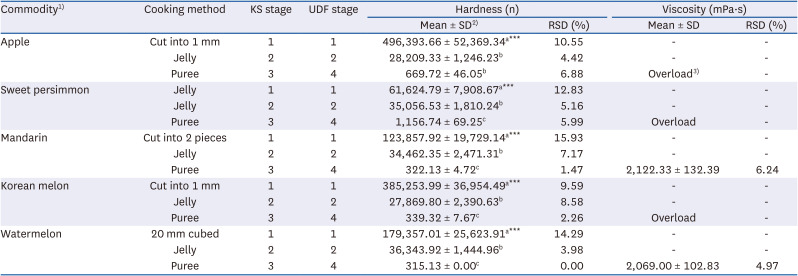2. Korea Disease Control and Prevention Agency (KDCA). 2020 Korea’s National Health Statistics, 8th Korean National Health and Nutrition Survey [Internet]. Osong: Korea Disease Control and Prevention Agency;2021. cited 2023 March 25. Available from:
https://knhanes.kdca.go.kr/.
3. Ikebe K, Hazeyama T, Morii K, Matsuda K, Maeda Y, Nokubi T. Impact of masticatory performance on oral health-related quality of life for elderly Japanese. Int J Prosthodont. 2007; 20:478–485. PMID:
17944335.
4. Martin BJ, Corlew MM, Wood H, Olson D, Golopol LA, Wingo M, Kirmani N. The association of swallowing dysfunction and aspiration pneumonia. Dysphagia. 1994; 9:1–6. PMID:
8131418.
7. Choi KJ, Park YS, Seong MY, Oh BM, Shin WS. Designed meal development and sensory evaluation for dysphagia patients. J Korean Dysphagia Soc. 2021; 11:15–24.
8. Jang MS, Oh JY, Kim PH, Park SY, Kim YY, Kang SI, Kim JS. Preparation and quality characteristics of different mackerel Scomber japonicas-based processed products as senior-friendly seafoods. Korean J Fish Aquat Sci. 2021; 54:703–713.
9. Boo KW, Kim BG, Lee SJ. Physicochemical and sensory characteristics of enzymatically treated and texture modified elderly foods. Korean J Food Sci Technol. 2020; 52:495–502.
10. Park SY, Park SH, Oh J, Jang M, Kim J. Development and quality characteristics of hamburg steak, cooked rice with vegetables, and white stew for senior-friendly seafoods using the pacific anchovy Engraulis japonicus
. Korean J Fish Aquat Sci. 2022; 55:257–266.
12. Alissa EM, Ferns GA. Dietary fruits and vegetables and cardiovascular diseases risk. Crit Rev Food Sci Nutr. 2017; 57:1950–1962. PMID:
26192884.
13. Ibiebele TI, van der Pols JC, Hughes MC, Marks GC, Williams GM, Green AC. Dietary pattern in association with squamous cell carcinoma of the skin: a prospective study. Am J Clin Nutr. 2007; 85:1401–1408. PMID:
17490979.
14. Rodriguez-Casado A. The health potential of fruits and vegetables phytochemicals: notable examples. Crit Rev Food Sci Nutr. 2016; 56:1097–1107. PMID:
25225771.
15. Kushi LH, Byers T, Doyle C, Bandera EV, McCullough M, McTiernan A, Gansler T, Andrews KS, Thun MJ. American Cancer Society 2006 Nutrition and Physical Activity Guidelines Advisory Committee. American Cancer Society Guidelines on Nutrition and Physical Activity for cancer prevention: reducing the risk of cancer with healthy food choices and physical activity. CA Cancer J Clin. 2006; 56:254–281. PMID:
17005596.
16. Liu S, Manson JE, Lee IM, Cole SR, Hennekens CH, Willett WC, Buring JE. Fruit and vegetable intake and risk of cardiovascular disease: the Women’s Health Study. Am J Clin Nutr. 2000; 72:922–928. PMID:
11010932.
17. Sesso HD, Buring JE, Christen WG, Kurth T, Belanger C, MacFadyen J, Bubes V, Manson JE, Glynn RJ, Gaziano JM. Vitamins E and C in the prevention of cardiovascular disease in men: the Physicians’ Health Study II randomized controlled trial. JAMA. 2008; 300:2123–2133. PMID:
18997197.
18. Kantorowicz M, Olszewska-Czyż I, Lipska W, Kolarzyk E, Chomyszyn-Gajewska M, Darczuk D, Kaczmarzyk T. Impact of dietary habits on the incidence of oral diseases. Dent Med Probl. 2022; 59:547–554. PMID:
36507621.
19. Koo SM, Park YJ, Hwang JY. Association between consumption of fruits and vitamin c and generalized periodontitis in Korean adults: the 2007-2010 Korean National Health and Nutrition Examination Surveys. Korean J Dent Mater. 2013; 40:77–85.
20. Baumann A, Brandt A, Bergheim I. Fructose, a trigger of metabolic diseases? a narrative review. Explor Dig Dis. 2022; 1:51–71.
21. Lore H. Fructose: metabolism and health effects. Benjamin C, editor. Encyclopedia of Human Nutrition. 4th ed. Philadelphia, PA: Elsevier Ltd.;2023. p. 389–396.
22. Ministry of Health and Welfare (KR). The Korean Nutrition Society. Dietary Reference Intakes for Koreans 2020. Sejong: Ministry of Health and Welfare;2022. p. 71–79.
23. National Institute of Agricultural Sciences (KR). Report of Technology Development to Improve Fruit Intake of the Elderly According to Their Chewing Ability. Wanju: National Institute of Agricultural Sciences;2022. p. 5–19.
24. Cha E, Yi H, Lim S, Chun J. Preparation and quality characteristics of jelly according to various gelling agents. Food Eng Prog. 2022; 26:51–59.
25. Hwang ES, Moon SJ. Quality characteristics and antioxidant activity of stick jelly made with different amount of tomato juice. J Korean Soc Food Sci Nutr. 2021; 50:476–482.
26. Jeong JS, Park SJ, Son BG. Quality characteristics of jelly using fresh puree of Sansuyu (Corni fructus). J Korean Soc Food Sci Nutr. 2017; 46:83–91.
27. Lee GD, Kim SK, Kwon DY, Park SR. Monitoring the manufacturing characteristics of aloe gel-state food. J Korean Soc Food Sci Nutr. 2003; 32:89–95.
28. Lee HJ, Choi KJ, Park YS, Shin WS. Survey of dysphagia meal management for the elderly and the disabled. Korean J Food Sci Technol. 2022; 54:35–42.
29. Korean Agency for Technology and Standards. Korean Industrial Standards Seniors Friendly Foods (KS H 4897) [Internet]. Eumseong: Korean Agency for Technology and Standards;2022. cited 2023 February. Available from:
https://standard.go.kr/KSCI/portalindex.do.
30. International Dysphagia Diet Standardization Initiative (IDDSI). Complete IDDSI framework detailed definitions 2.0 [Internet]. New Westminster: International Dysphagia Diet Standardization Initiative;2019. cited 2023 March 21. Available from:
https://iddsi.org/Framework.
31. National Institute of Agricultural Sciences (KR). Cooking Guide for the Elderly. Seoul: Yemun Publishing Co.;2018. p. 37–93.
32. National Institution of Agricultural Sciences. Korean Food Composition Table. 10th ed. Wanju: Rural Development Administration;2021. p. 82–269.
34. Cichero JA. Thickening agents used for dysphagia management: effect on bioavailability of water, medication and feelings of satiety. Nutr J. 2013; 12:54. PMID:
23634758.
35. Matta Z, Chambers E 4th, Mertz Garcia J, McGowan Helverson JM. Sensory characteristics of beverages prepared with commercial thickeners used for dysphagia diets. J Am Diet Assoc. 2006; 106:1049–1054. PMID:
16815121.










 PDF
PDF Citation
Citation Print
Print

































































 XML Download
XML Download